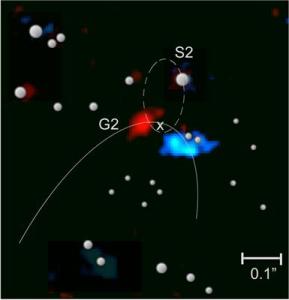Nov 25 2014
In November, astronomers at the Max Planck Institute for Extraterrestrial Physics presented new observations of the gas cloud G2 in the galactic centre originally discovered in 2011. These data are in remarkably good agreement with an on-going tidal disruption. As a complete surprise came the discovery that the orbit of G2 matches that of another gas cloud detected a decade ago, suggesting that G2 might actually be part of a much more extensive gas streamer. This would also match some of the proposed scenarios that try to explain the presence of G2. One such model is that G2 is originating from the wind from a massive star.
 April 2014: High-resolution image of the gas cloud G2 at the centre of our Milky Way with the SINFONI instrument at the VLT. The red part of the cloud approaches the 4 million solar masses black hole (indicated with a cross) at velocities of a few thousand km/s. The blue part has already passed the closest distance to the black hole and moves away again. The initially spherical could has been stretched by the strong gravitational field of the black hole by a factor 50 in the direction of motion. The cloud's size from red to blue now corresponds to 900 times the Earth-Sun distance. The solid line shows the orbit of the gas cloud. The dashed lines show the orbit of the star with the best known orbit (S2). The positions of the neighbouring stars are indicated as well. (c) MPE
April 2014: High-resolution image of the gas cloud G2 at the centre of our Milky Way with the SINFONI instrument at the VLT. The red part of the cloud approaches the 4 million solar masses black hole (indicated with a cross) at velocities of a few thousand km/s. The blue part has already passed the closest distance to the black hole and moves away again. The initially spherical could has been stretched by the strong gravitational field of the black hole by a factor 50 in the direction of motion. The cloud's size from red to blue now corresponds to 900 times the Earth-Sun distance. The solid line shows the orbit of the gas cloud. The dashed lines show the orbit of the star with the best known orbit (S2). The positions of the neighbouring stars are indicated as well. (c) MPE
The gas cloud G2 was originally detected by Stefan Gillessen and his colleagues at the Max Planck Institute for Extraterrestrial Physics (MPE) in 2011. It is on a highly eccentric orbit around the galactic centre and observations in 2013 have shown that part of the gas cloud is already past its closest approach to the black hole, at a distance of roughly 20 light hours (a bit more than 20 billion kilometres or 2000 Schwarzschild radii). The new, deep infrared observations with the SINFONI instrument at the VLT track the ongoing tidal disruption of the gas cloud by the powerful gravitational field. While the shape and path of the gas cloud agrees well with predictions from the models, so far there has been no significant enhanced high-energy emission, as one might have expected from the associated shock front.
But a closer look into the data set led to a surprise. “Already a decade ago, another gas cloud – which we now call G1 – has been observed in the central region of our galaxy,” remarks Stefan Gillessen. “We explored the connection between G1 and G2 and find an astonishing similarity in both orbits.”
The faint and blurry object G1 can be seen in the data sets from 2004 to 2008. The MPE team was able to determine also G1’s orbit. This revealed that it has already passed pericenter in 2001. The similarity of the orbits thus suggests that G1 is about 13 years ahead of G2. The scientists fed this information into a model for a combined orbit, taking into account the different pericentre times and allowing for slightly different orbits due to interaction of the gas with the ambient medium after pericentre passage.
“Our basic idea is that G1 and G2 might be clumps of the same gas streamer”, explains Oliver Pfuhl, lead author of the study presented in the recent paper. “In this case, we should be able to simultaneously fit both data sets and, indeed, our model captures the G1 and G2 orbits remarkably well.”
The model makes the simple assumption that G1 was decelerated during pericentre passage by a drag force due to the thin atmosphere that surrounds the massive black hole. This drag pushed it into a more circular orbit. Using just this very simple assumption the emission of both G1 and G2 apparently trace the same orbit. Small deviations from the fit are not surprising given the simplicity of the model, which likely is neglecting some essential physics.
“The good agreement of the model with the data renders the idea that G1 and G2 are part of the same gas streamer highly plausible,” states Gillessen. A likely source for both G1 and G2 could then be clumps in the wind of one of the massive disk stars, which could have been ejected some 100 years ago close to the apocentre of the G2 orbit. Another possible explanation that has been suggested recently would be a large star, enveloped by an extended gas cloud. Based on the current VLT data, however, this model is highly unlikely.
Moreover, the gas streamer picture could also help to explain the missing X-ray emission from the gas cloud near the black hole, although the non-detection of such emission is not yet understood.